Home | Chess game basics | Chess pieces | Chess rules | Play
chess online | ChessLab | Chess links
The king |
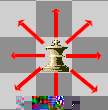 |
The legal moves for the king are shown as
arrows in the diagram on the left. The king can move to any of the squares pointed to by
an arrow. The king is the main chess piece. The side whose king is captured loses. This
capture is called 'checkmate'. Checkmate happens once the king is under attack, cannot
move and cannot be helped by its own army of chessmen. To
underscore the highest relative value of the king (relative to other pieces) in a chess
game, in early computer chess programs, the king was assigned a value of 200 points. |
|
| |
The queen |
 |
For the queen, the legal moves are shown
as arrows in the diagram on the left. The queen can move any number of squares diagonally
and also in horizontal and vertical directions. The queen, however, cannot jump over any
pieces. The diagram on the left illustrates that the queen can move to any of the squares
pointed to by an arrow and also to any of the squares marked with red dots. To underscore the high relative value of the queen (relative to other chess
pieces) in a chess game, in early computer chess programs, the queen was assigned a value
of 9 points. |
|
| The rook |
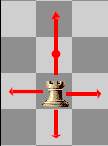 |
For the rook, the legal moves are shown in
the diagram on the left. The rook can move any number of squares in horizontal and
vertical directions. The rook, however, cannot jump over any pieces. The diagram on the
left illustrates that the rook can move to any of the squares pointed to by an arrow and
also to a square marked with a red dot. To underscore
the relative value of the rook in a chess game, in early computer chess programs, the rook
was assigned a value of 5 points. |
|
|
The bishop |
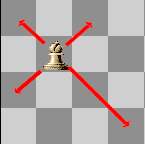 |
The legal moves for the bishop are shown
in the diagram on the left. The bishop can move any number of squares diagonally only. The
bishop, however, cannot jump over any pieces. The diagram on the left illustrates that the
bishop can move to any of the squares pointed to by an arrow. To underscore the relative value of the bishop relative to other chess pieces
in a chess game, in early computer chess programs, the bishop was assigned a value of 3
points.
|
|
| The knight |
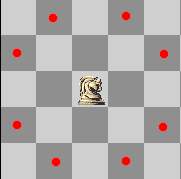 |
The diagram on the left shows all legal
moves for the knight. The knight can move from one corner to the other of any 2x3
rectangle of squares. The knight is also the only piece that can jump over any other chess
pieces. The diagram on the left illustrates that the knight can move to any of the
squares pointed to by a red dot. To underscore the
relative value of the knight (relative to other chess pieces) in a chess game, in early
computer chess programs, the Knight was assigned a value of 3 points. |
|
|
| The pawn |
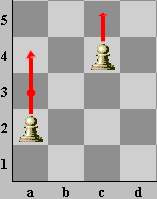 |
The pawn's legal moves are shown in the
diagram on the left. The pawn can move from straight ahead only. From its starting square,
the pawn can move or 2 squares straight ahead. If the pawn is not on its starting
square, it can only move 1 square straight ahead. The diagram on the left illustrates that
the pawn can move to any of the squares pointed to by an arrow and a red dot. Although
pawns move only forward, they capture only sideways 1 square diagonally forward -- see
diagram in Chess Rules) To
underscore the value of the pawn relative to other chess pieces in a chess game, in early
computer chess programs, the Pawn was assigned a value of 1 point. |
|
|
| |
| Home | Chess game
basics | Chess pieces | Chess rules | Play chess online | ChessLab | Contact us | Chess links |
|
|
|
